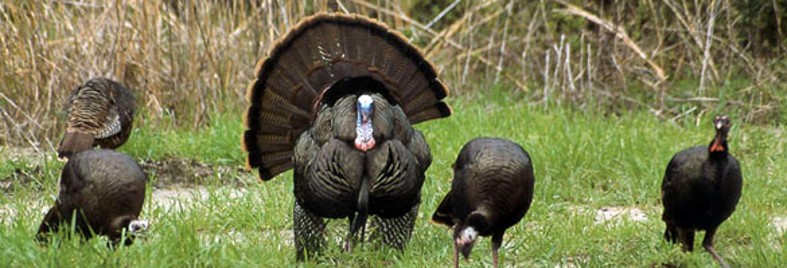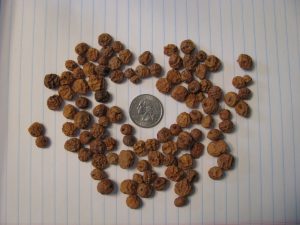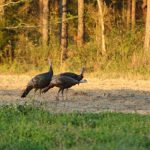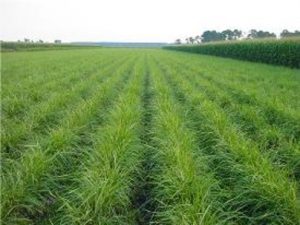Wildlife management continues to be an area of growing interest on our local farms and ranches and has the potential to generate significant additional income to the farm enterprise. It is also an opportunity to practice good stewardship of the natural resources that we have in abundance here in the Panhandle. Each spring I get many phone calls from landowners wanting to know what they can plant to encourage wild turkeys to utilize their property more and to enhance the quality of their wild turkey habitat. Chufa is one such plant that wild turkeys love like most of us love ice cream and it is easy to grow and will provide feed for turkeys for several months.
What is chufa? Chufa is an African variety of the native nutsedge, which is a warm season perennial plant. However, chufa is not as aggressive as the native nutsedges and typically will not create problems with succeeding crops that you might plant after it. The actual foliage of the plant is not utilized by wildlife, but turkeys, hogs, ducks, and raccoons love the underground tubers that the plant produces. Each individual plant can produce 10 to 75 peanut kernel sized tubers (see photo 1) that wildlife utilize. These tubers are high in carbohydrates and protein, and they are also edible by humans, having a sweet taste similar to almonds or raw peanuts.
Turkeys will usually begin to dig the chufas up in early fall as soon as the above ground leaves turn brown. In Florida, they will dig and eat the nuts from fall throughout the winter and into spring. (see photo 2 of turkeys feeding in a spring chufa patch)
If you are considering planting chufa there are several considerations to take into account. The chufa plant typically grows well anywhere that field corn can be grown. You should soil test the area you intend to plant and lime to a pH between 6.0 – 6.5. On most soils this requires 1 ton of lime per acre. Recommended planting dates are April 1st through June 30th in the panhandle area. Earlier plantings will provide higher yields, whereas later plantings typically will provide foraging for wildlife later into the following spring. To maximize use by turkeys into the spring I would recommend looking at planting in June. Chufa can be planted later than June 30th some years but remember that it takes the plant approximately 90 days to produce mature tubers and this must be accomplished prior to frost/cold weather. Plant the seed into a well prepared and fertilized seedbed. The seeding rate for chufa is 40 – 50 pounds per acre broadcast or 30 pounds per acre drilled on a 36 inch row spacing. Strive for a coverage of 3 or 4 seed per square foot. When broadcasting the seed, set your disk to cut about 4 inches deep. This will cover the seed to an approximate depth of 2 inches which is ideal for chufa. Normal fertilizer recommendations would be 200 pounds of 17-17-17 per acre or equivalent at planting. When the plants are 6 – 12 inches high (approximately 1 month old) you should top dress with 100 pounds of actual N per acre (300 pounds of ammonium nitrate) to maximize yields. With high costs of fertilizer this may not be as desirable, but yields will be smaller if fertilizer rates are reduced. For weed control options on chufa plantings consult with your local County Extension Agent for up-to-date recommendations.
Small plantings are feasible (less than ¼ acre) if wild hogs are not present. It has been my experience that best results are obtained with ½ acre or larger plantings. Chufa is a plant that will do a good job of reseeding itself, sometimes for several years. Reseeding can be accomplished by simply disking the area of the previous planting between April and the end of June and following fertilizer recommendations for the initial planting. For most locations it is advisable to move the chufa plot to a different location after the second crop to avoid problems with soil pests. (see photo 3 of typical planting).
If you have never planted chufas before for your turkeys, you may want to pull some up or disk a row up in the fall after the tops have died back. This will assist the turkeys in finding the plants if they have never encountered it before. Once they do find it you can expect to find tremendous areas of scratching. Quite often the plots will literally look like a mortar or bombing range where the turkeys dig down to get the chufas!
For more information consult with your local Extension Agent .
- Wildlife Food Plots: Chufa for Wild Turkeys - March 27, 2020
- Wild Turkey Biology and Habitat Management - November 14, 2019
- Aquatic Weed Control – Common Salvinia - September 13, 2019




